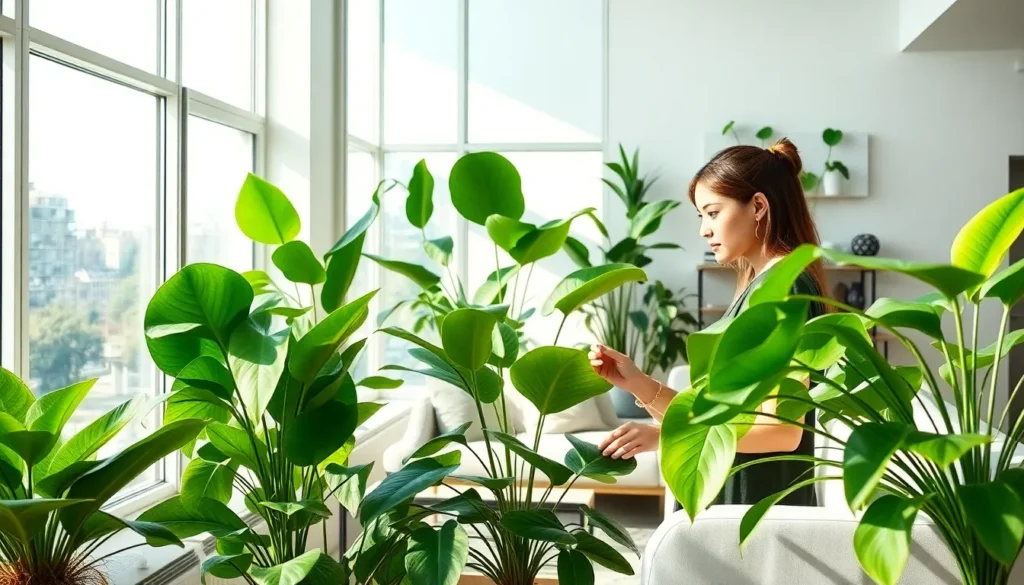We’re witnessing a botanical revolution sweeping through contemporary homes as modern architecture embraces the power of plants. Today’s homeowners aren’t just decorating with greenery – they’re creating living ecosystems that transform sterile spaces into vibrant sanctuaries.
The fusion of sleek modern design with lush plant life creates an irresistible contrast that’s both visually stunning and incredibly beneficial for our wellbeing. From towering floor-to-ceiling windows that frame garden views to innovative indoor growing systems that turn walls into vertical forests, we’re discovering countless ways to blur the lines between indoor and outdoor living.
Whether you’re planning a complete home renovation or simply looking to refresh your current space, incorporating plants into modern design isn’t just a trend – it’s a lifestyle choice that’ll enhance your home’s aesthetic appeal while improving air quality and boosting your mental health.
Choose the Right Plants for Your Modern House Design
Selecting plants that harmonize with your sleek interior architecture requires thoughtful consideration of both aesthetic and practical factors. We’ll help you identify the perfect botanical companions that enhance your contemporary living space.
Consider Light Requirements and Room Placement
Assess natural light availability in each room before making plant selections. South-facing windows receive the most intense sunlight throughout the day, making them ideal for light-loving plants like fiddle leaf figs and bird of paradise.
Match plants to exact lighting conditions in your modern home’s distinct zones. East-facing rooms with morning sun work perfectly for monstera deliciosa and rubber trees, while west-facing spaces with afternoon light accommodate snake plants and ZZ plants.
Position low-light tolerant species in areas with minimal natural illumination. Pothos, peace lilies, and Chinese evergreens thrive in bathrooms, hallways, and interior corners where traditional houseplants struggle.
Consider artificial lighting supplements for darker spaces in your modern layout. LED grow lights with sleek designs blend seamlessly with contemporary fixtures while supporting plant health in windowless areas.
Select Plants That Complement Minimalist Aesthetics
Choose plants with clean architectural lines that mirror your home’s geometric design elements. Sansevieria trifasciata creates striking vertical accents with its sword-like leaves, while monstera deliciosa offers bold sculptural presence through its distinctive split foliage.
Opt for monochromatic green varieties that maintain visual simplicity in minimalist spaces. Solid green plants like ZZ plants, rubber trees, and peace lilies provide organic texture without overwhelming neutral color palettes.
Select specimens with distinctive silhouettes that function as living art pieces. Single-stem plants such as fiddle leaf figs, Norfolk pines, and bamboo palms create focal points that complement modern furniture’s clean profiles.
Consider plants with interesting textures that add tactile dimension to smooth surfaces. Succulents like echeveria and jade plants introduce organic patterns, while ferns provide soft contrast against hard architectural materials.
Factor in Maintenance Levels for Busy Lifestyles
Prioritize drought-tolerant species that forgive inconsistent watering schedules. Succulents, snake plants, and ZZ plants store water in their tissues, requiring minimal attention while maintaining their striking appearance.
Choose plants with flexible care requirements that adapt to varying environmental conditions. Pothos and spider plants tolerate neglect while continuing to grow, making them perfect for frequent travelers or demanding work schedules.
Select slow-growing varieties that require minimal pruning and repotting. Sansevieria and jade plants maintain their shape for years without intervention, reducing the time commitment needed for plant care.
Invest in self-watering systems for higher-maintenance plants you love. Modern self-watering planters with sleek designs automate care routines while preserving your home’s contemporary aesthetic.
Create Stunning Plant Displays in Living Spaces
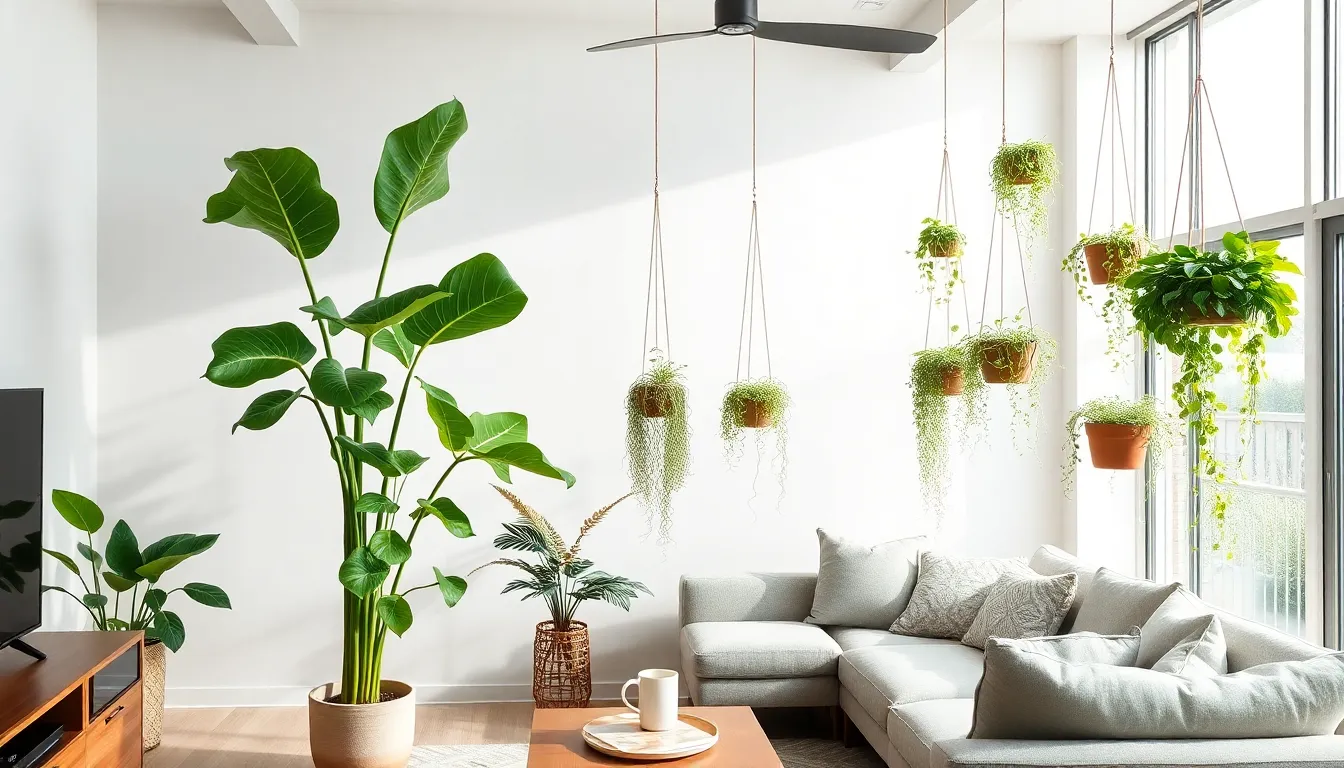
We can transform our living spaces into stunning botanical showcases by strategically placing plants throughout our rooms. Popular modern plants like fiddle leaf fig, monstera, philodendron, and snake plants bring natural beauty and architectural interest to contemporary interiors with their unique foliage shapes and varying sizes.
Design Statement Corners with Large Floor Plants
Large floor plants serve as dramatic focal points that instantly elevate our room’s design aesthetic. We recommend positioning tall plants like snake plants, rubber plants, fiddle leaf figs, and majesty palms in empty corners where they create vertical interest and draw the eye upward. These statement plants fill vertical space effectively while making our rooms feel larger and more expansive through their impressive height and structure.
Incorporate Hanging Planters for Vertical Interest
Hanging planters maximize our vertical space without consuming valuable floor area in modern homes. We can create layered greenery at multiple levels by suspending trailing plants from ceilings or wall-mounted brackets. This technique softens harsh architectural edges while introducing texture and visual complexity to our contemporary spaces. Hanging displays work particularly well in rooms with high ceilings where we want to create a sense of fullness and organic movement.
Use Plant Stands and Shelving for Layered Arrangements
Plant stands and shelving systems allow us to create curated, multi-dimensional displays that showcase plants as design elements. We can group plants of varying heights, shapes, and textures on different levels to build depth and visual interest throughout our rooms. This layered approach lets us mix trailing plants with upright varieties, creating ever-changing arrangements that support our modern aesthetic while maintaining the organized, intentional look that contemporary design demands.
Transform Your Kitchen into a Green Modern Sanctuary
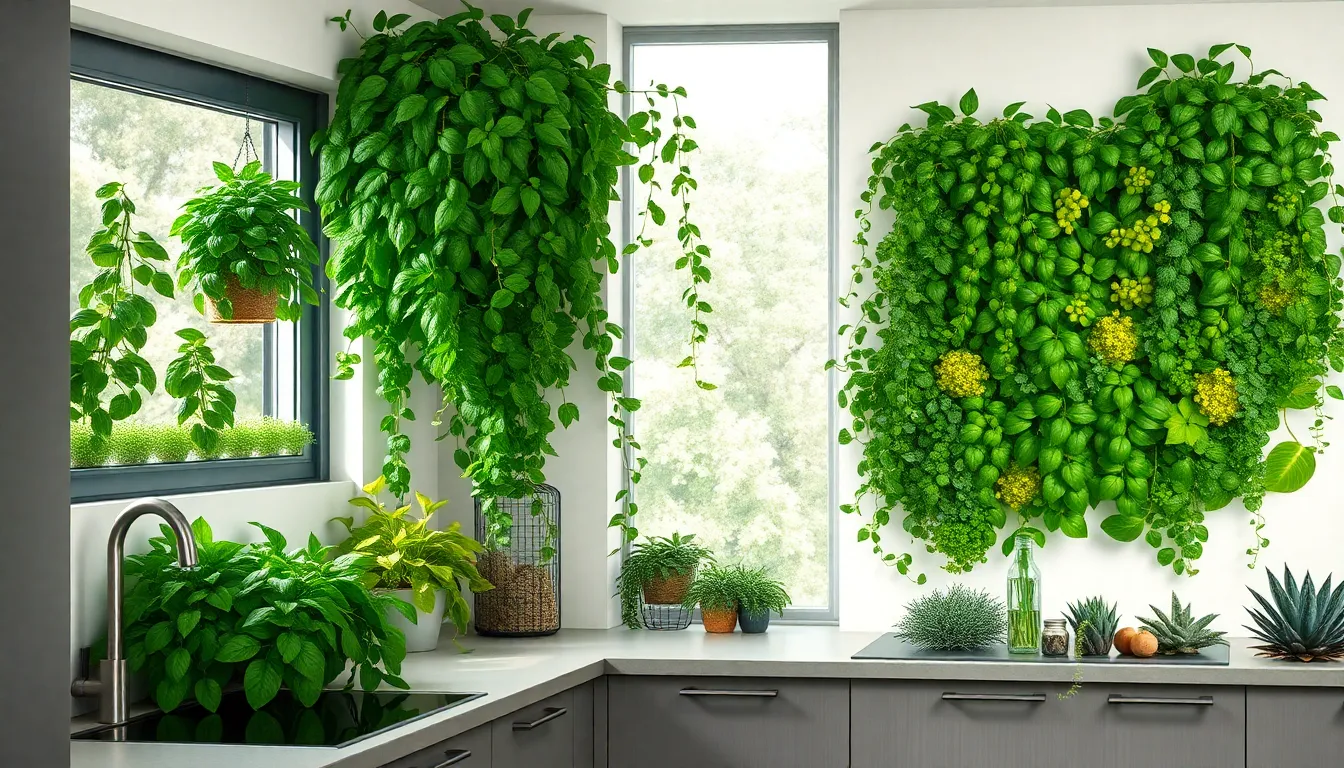
The kitchen represents the perfect space to blend functionality with botanical beauty. We’ll show you three strategic approaches to integrate plants seamlessly into your contemporary cooking space.
Install Herb Gardens on Windowsills
Windowsill herb gardens bring both culinary convenience and natural beauty to your modern kitchen. We recommend establishing collections of basil, thyme, and mint directly on your windowsills where they’ll receive optimal sunlight. These compact gardens provide fresh flavors for cooking while adding vibrant greenery to your space.
Growing herbs indoors creates a functional design element that serves dual purposes. Fresh herbs remain within arm’s reach during meal preparation, eliminating trips to the grocery store. The aromatic plants also contribute to a more pleasant cooking environment while maintaining the clean aesthetic of contemporary kitchen design.
Add Trailing Plants Above Cabinets
Trailing plants positioned above kitchen cabinets maximize unused vertical space effectively. We suggest incorporating pothos or philodendrons in this elevated position to create cascading greenery that softens modern architectural lines. These hanging varieties add visual movement and texture to otherwise stark cabinet tops.
Vertical placement allows trailing plants to grow naturally downward without interfering with counter workspace. The lush, cascading effect creates visual continuity between upper and lower kitchen elements. Most trailing varieties require minimal maintenance while delivering maximum visual impact in contemporary settings.
Create a Living Wall with Vertical Planters
Living walls serve as striking focal points that transform entire kitchen walls into green masterpieces. We recommend installing vertical planter systems that accommodate various herbs, leafy greens, and succulents for both visual appeal and air purification benefits. These installations create dramatic statements while maintaining practical growing spaces.
Vertical gardens optimize limited kitchen square footage by utilizing wall space efficiently. Multiple plant varieties can coexist within organized planter systems, creating diverse textures and colors. The living wall concept integrates seamlessly with modern design principles while providing ongoing harvesting opportunities for cooking enthusiasts.
Design a Plant-Filled Modern Bedroom Retreat
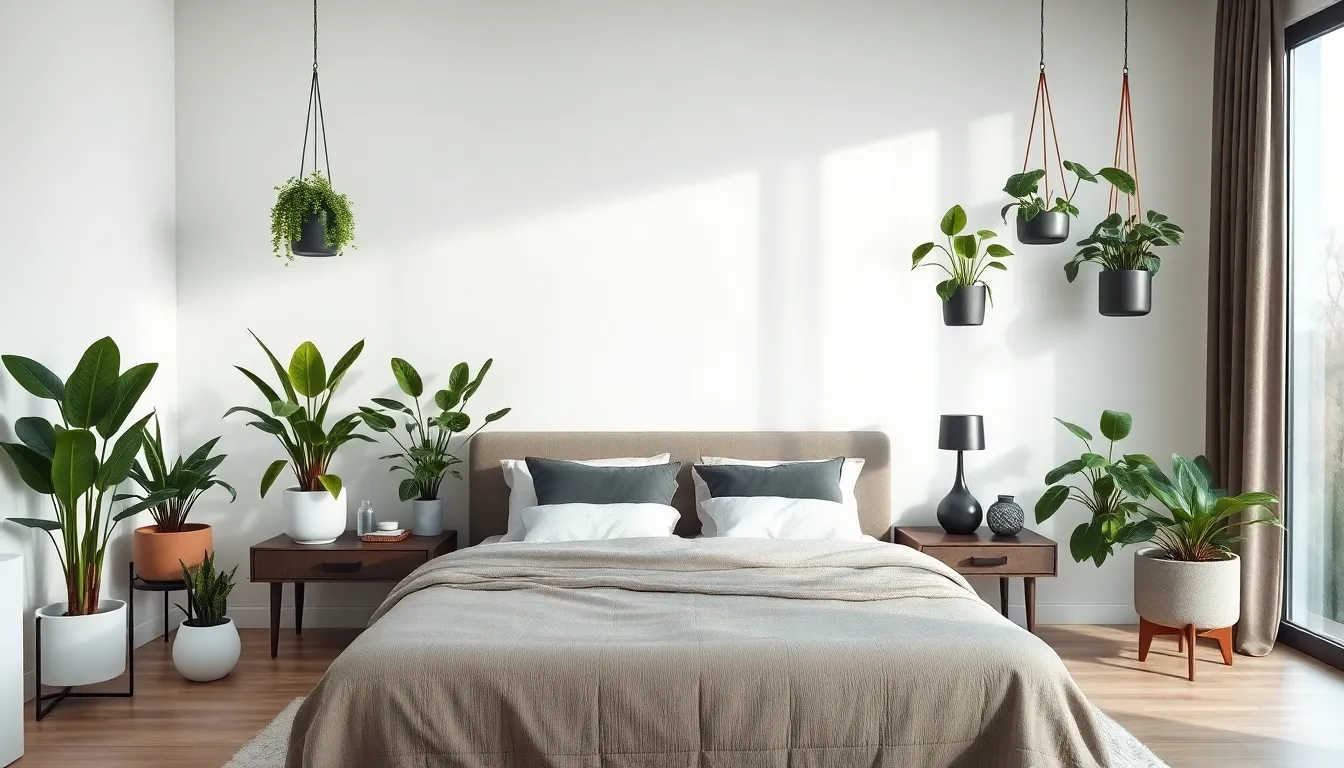
Transforming your bedroom into a modern plant retreat creates a tranquil sanctuary that promotes restful sleep and enhances your home’s contemporary aesthetic. We’ll explore strategic approaches to integrate greenery into your personal space for maximum wellness benefits.
Choose Air-Purifying Plants for Better Sleep
Snake plants excel at producing oxygen during nighttime hours, making them perfect bedroom companions for better air quality. These sculptural beauties require minimal care while actively working to purify your sleeping environment throughout the night.
Fiddle leaf figs bring striking foliage and modern appeal to contemporary bedrooms while filtering harmful toxins from indoor air. Their large, glossy leaves create dramatic focal points that complement minimalist design principles.
Philodendrons offer compact growth with interesting leaf patterns that thrive in bedroom conditions. These versatile air purifiers adapt well to various light levels while maintaining their lush appearance year round.
Cast iron plants tolerate low light conditions exceptionally well, making them ideal for bedrooms with limited natural illumination. Their sturdy, dark green leaves require virtually no maintenance while continuously improving indoor air quality.
Position Plants Near Natural Light Sources
Window placement maximizes plant health by providing bright, indirect sunlight that most indoor varieties need to flourish. We recommend positioning larger specimens like fiddle leaf figs within three feet of east or west facing windows for optimal growth.
Filtered light prevents harsh sun exposure that can damage delicate leaves while ensuring adequate illumination for photosynthesis. Sheer curtains or blinds help diffuse direct sunlight, creating perfect growing conditions for most houseplants.
Low light alternatives like snake plants and cast iron plants thrive even in bedrooms with minimal natural light exposure. These resilient varieties can flourish in corners or areas several feet away from windows without compromising their health or appearance.
Use Bedside Plant Displays for Ambiance
Small potted plants on nightstands create intimate green spaces that promote relaxation before sleep. Prayer plants and small philodendrons work particularly well in these intimate settings, adding natural texture without overwhelming bedside areas.
Hanging planters maximize vertical space while introducing soft, cascading greenery that enhances the bedroom’s peaceful atmosphere. Trailing varieties like pothos or small philodendrons create gentle movement that soothes the mind during evening routines.
Minimalist planters in sleek ceramic or concrete complement modern bedroom aesthetics while showcasing your chosen plants beautifully. These contemporary containers maintain the clean lines essential to modern design while providing proper drainage for healthy plant growth.
Integrate Plants into Modern Bathroom Spaces
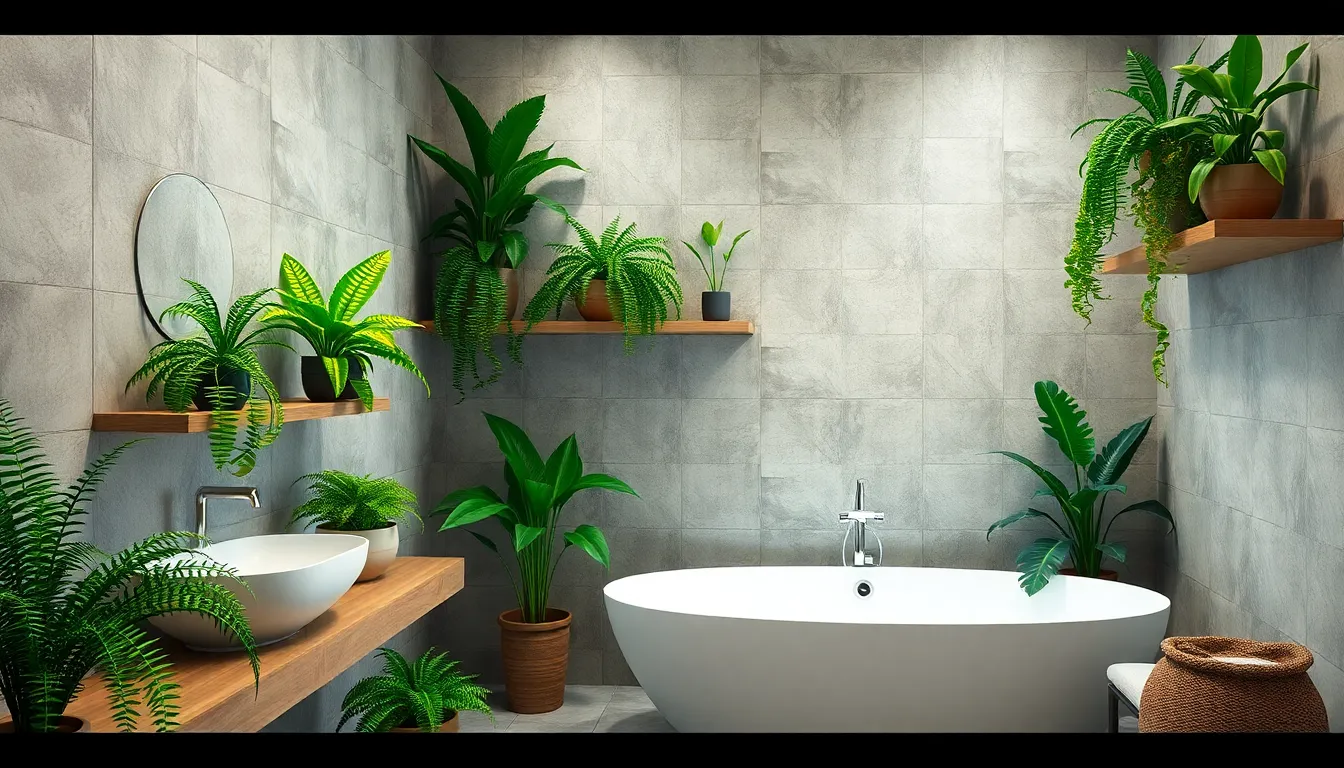
Bathrooms present unique opportunities for plant integration due to their naturally humid environments and potential for creating wellness-focused spaces.
Select Humidity-Loving Species for Shower Areas
Choosing moisture-tolerant plants transforms shower zones into lush retreats. Ferns thrive in bathroom humidity and create cascading green displays near shower areas. Spider plants adapt perfectly to fluctuating moisture levels while adding delicate texture to modern fixtures. Orchids bring elegant blooms that complement sleek bathroom surfaces and flourish in steamy conditions.
Cast Iron Plants offer exceptional durability for low-light bathroom corners. These resilient species tolerate indirect lighting conditions commonly found in interior bathrooms. Snake Plants provide vertical interest with their architectural leaves while surviving both humid and dry periods. Philodendrons deliver heart-shaped foliage that softens hard bathroom surfaces and thrives in moisture-rich environments.
Install Floating Shelves for Small Plant Collections
Floating shelves maximize vertical space without cluttering floor areas. We can position these shelves at eye level to create visual interest while maintaining clean modern lines. Small plant collections on floating shelves add greenery without sacrificing precious bathroom real estate.
Strategic shelf placement creates layered plant displays throughout the bathroom. Installing shelves near windows captures natural light for plant growth while improving the room’s brightness. Multiple shelf levels accommodate various plant sizes from compact succulents to trailing pothos varieties.
Create Spa-Like Atmosphere with Greenery
Lush foliage transforms sterile bathrooms into calming natural retreats. Green plants soften sleek surfaces like marble countertops and glass shower doors while promoting relaxation. Natural elements create visual balance against contemporary fixtures and hard architectural materials.
Plant placement near bathtubs enhances the spa experience during relaxation time. We can position larger plants like rubber trees in bathroom corners to create dramatic focal points. Combining various plant textures from smooth snake plant leaves to delicate fern fronds adds depth and tranquility to modern bathroom spaces.
Style Your Modern Home Office with Productive Plants

Extending our plant integration journey into the workspace creates opportunities for enhanced productivity and visual appeal. Modern home offices benefit significantly from thoughtfully selected botanical companions that support both function and form.
Boost Concentration with Desk-Friendly Plants
Desk placement becomes strategic when we select low maintenance plants like succulents, snake plants, and pothos that thrive in indoor environments. These varieties require minimal care while creating calm, inviting atmospheres that boost mood and decrease stress levels.
Productivity increases measurably with live plants positioned on or near workstations. The University of Exeter study demonstrates workplace productivity can rise by up to 15% with just a few houseplants strategically placed in the office environment.
Enhanced creativity emerges from plant integration, as studies link foliage presence to improved job satisfaction and reduced mental fatigue. Plants promote sustained focus by creating natural visual breaks that prevent cognitive overload during intensive work sessions.
Mental well-being improves significantly when we incorporate greenery into daily work routines. The refreshing green backdrop provides psychological benefits that extend beyond mere decoration, actively supporting concentration and cognitive function.
Design Green Backgrounds for Video Calls
Contemporary aesthetics shine through plant filled backgrounds that create natural, professional video call environments. Lush foliage reflects modern design trends while projecting a healthy, productive workspace image to colleagues and clients.
Depth and softness emerge when we position taller plants or abundant foliage near camera backdrops. This strategic placement adds visual interest and warmth to otherwise sterile home office setups.
Professional perception enhances as others view plant integrated workspaces as indicators of thoughtful design and wellness focused priorities. Green backgrounds communicate environmental consciousness and attention to detail.
Visual appeal increases dramatically through careful plant selection for video conferencing areas. We can create ever-changing, captivating backgrounds that maintain professionalism while showcasing personal style and modern sensibilities.
Improve Air Quality in Work Spaces
Natural air purification occurs when plants absorb common indoor toxins like formaldehyde, benzene, and carbon monoxide found in typical home environments. Spider plants, pothos, and rubber plants excel as effective air purifiers suited for modern homes.
Oxygen levels rise while humidity increases through plant respiration, creating healthier indoor atmospheres that support sustained work performance. These environmental improvements directly impact comfort and cognitive function.
Health symptoms decrease as cleaner air reduces headaches, fatigue, and respiratory discomfort commonly experienced in enclosed workspaces. Plants create naturally ventilated environments that promote overall well-being.
Workspace atmosphere transforms through improved air quality that supports longer, more comfortable work sessions. We experience tangible benefits from enhanced indoor environments that plants create through their natural biological processes.
Maximize Outdoor Connections with Indoor Plants
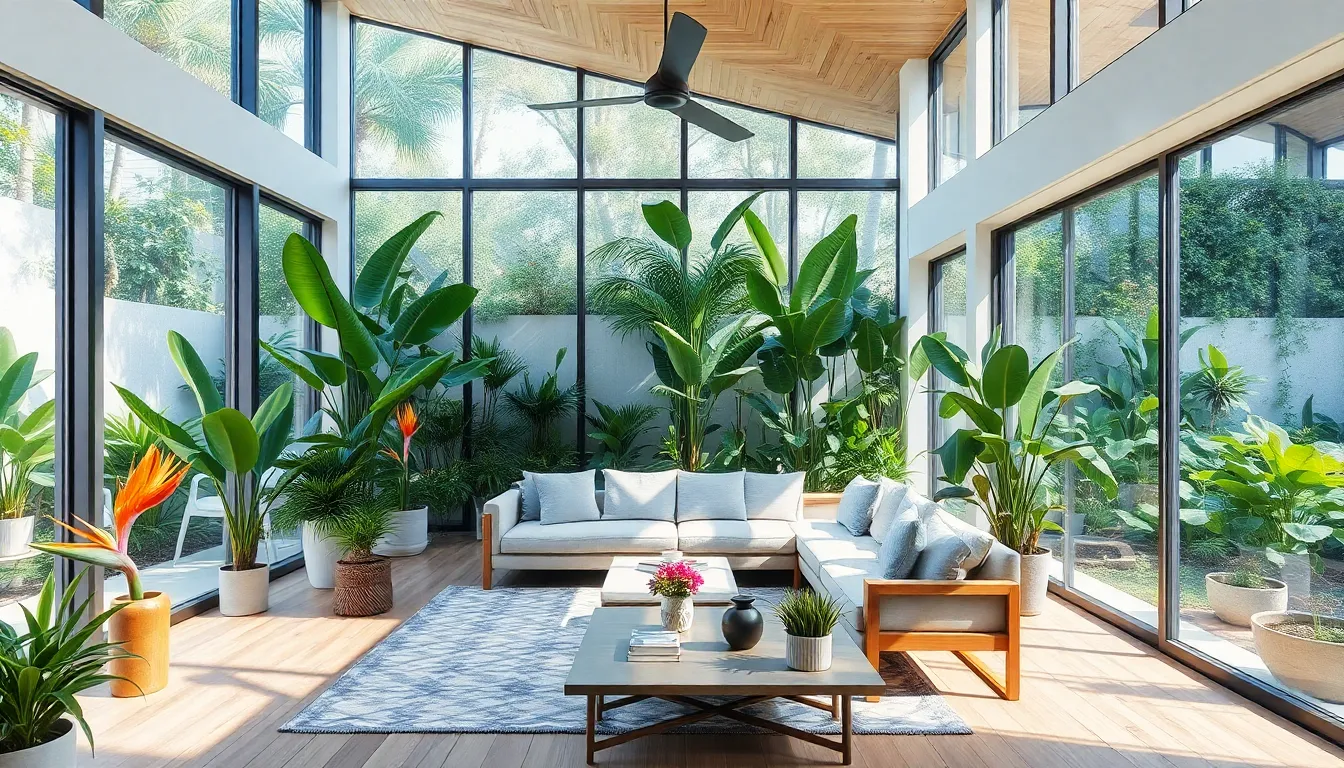
Modern house designs achieve their most stunning results when we blur the boundaries between indoor and outdoor living spaces. Grouping houseplants strategically throughout our homes creates an immersive environment that makes us feel like we’re walking through natural greenery indoors.
Bridge Interior and Exterior Spaces with Similar Species
Connecting our interior and exterior plant selections creates visual continuity that transforms separate areas into one cohesive living space. We can achieve this seamless integration by choosing similar or matching plant species for both indoor and outdoor areas.
Tropical plants like papaya, banana, and mango work exceptionally well for creating jungle-like integration between indoor pavilions and surrounding outdoor spaces. These bold species maintain their visual impact whether placed in large indoor containers or planted in outdoor garden beds.
We’ll find that repeating plant families throughout different zones strengthens the connection between our home’s various living areas. Palm varieties, for instance, can transition from indoor Kentia palms to outdoor date palms, maintaining the same architectural feel while adapting to different environmental conditions.
Use Large Windows to Showcase Plant Collections
Large windows in contemporary architecture serve dual purposes: they flood our spaces with natural light while transforming our plant collections into living art displays. These expansive glass elements create stunning showcases for our indoor greenery against the backdrop of outdoor landscapes.
We can position our most striking plants near these window features to maximize their visual impact. Floor-to-ceiling windows work particularly well for displaying tall specimens like Bird of Paradise or Dracaena Marginata, creating dramatic silhouettes that connect with outdoor views.
Positioning plants of varying heights and textures near windows creates layered compositions that draw the eye naturally from indoor spaces to outdoor garden areas. Snake plants, Peperomia, and Calatheas arranged at different levels provide dimensional interest while maintaining clear sight lines to exterior landscapes.
Create Seamless Flow Between Garden and Home
Open floor plans combined with transitional spaces make our outdoor gardens integral parts of daily living rather than separate entities. Indoor/outdoor kitchens and dining areas invite the industry to flow naturally in and out of our building structures.
We can enhance this flow by incorporating natural lines and geometry from our home’s architecture into our garden design. Repeating materials like stone, wood, or metal between indoor and outdoor spaces creates visual threads that tie everything together.
Climate-appropriate plants in stylish containers positioned near transition zones reinforce the connection between indoor and outdoor environments. These strategic placements make it feel like our garden extends continuously from exterior beds through doorways and into interior living areas.
Maintain Your Modern House Plants Successfully
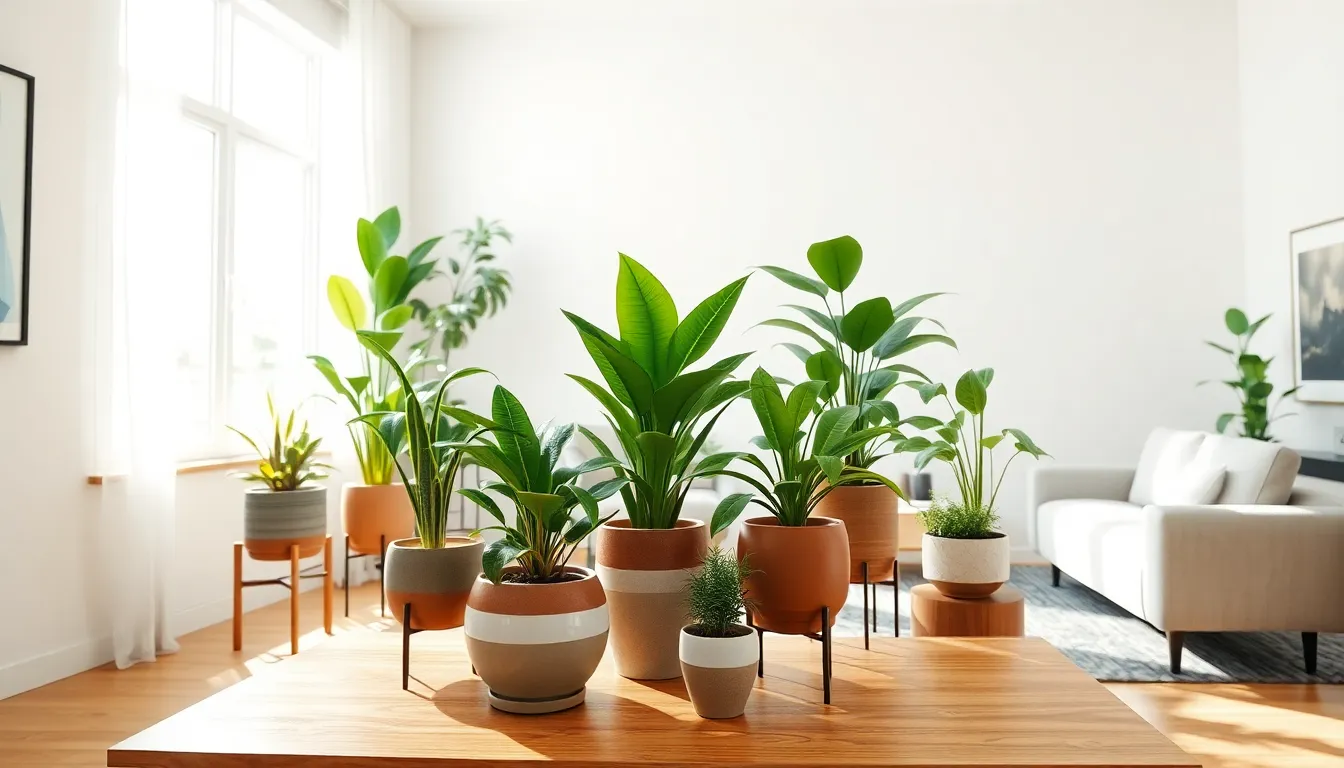
Now that we’ve created our green sanctuary throughout the home, we need to focus on keeping these botanical elements thriving in our contemporary spaces.
Establish Consistent Watering Schedules
Watering schedules form the foundation of successful plant maintenance in modern homes. We should keep potting soil consistently moist but never waterlogged, as both extremes can damage our plants. Different species require varying amounts of water throughout the year—cacti need significantly less water during winter months compared to tropical varieties.
Developing a regular routine based on each plant’s exact needs prevents both under and overwatering issues. We can use self-watering containers or plant spikes if we tend to forget our watering responsibilities. Seasonal adjustments become crucial as heating systems and changing daylight hours affect how quickly soil dries out in our modern spaces.
Regular monitoring helps us identify when our plants need water by checking soil moisture levels rather than following rigid schedules. We’ll notice that plants near heating vents or large windows may require more frequent watering than those in shadier corners.
Provide Proper Drainage and Pot Selection
Drainage systems prevent the root rot that commonly destroys houseplants in contemporary homes. We must choose pots with adequate drainage holes to allow excess water to escape freely. Well-draining potting soil suited to each plant type provides essential nutrients while protecting roots from waterlogged conditions.
Container selection impacts both plant health and our modern aesthetic—ceramic and terracotta pots offer excellent drainage while complementing clean architectural lines. We should only repot plants when they outgrow their current containers to avoid unnecessary transplant stress.
Pot sizing affects watering frequency and plant stability in our modern spaces. Oversized containers hold too much moisture, while undersized pots dry out quickly and may topple over. We can elevate pots on plant stands or saucers to protect floors while ensuring proper drainage.
Monitor Plant Health and Growth Patterns
Plant health indicators tell us when our green companions need attention or care adjustments. We should observe leaf color and texture regularly—yellowing leaves often signal overwatering, while brown edges indicate insufficient humidity or too much direct sunlight.
Growth patterns reveal how well our plants adapt to their modern environment. Slow growth might indicate inadequate light, while leggy growth suggests plants are stretching toward available light sources. We need to check for pests or diseases during our regular observations, catching problems before they spread to other plants.
Light exposure requirements vary significantly between species, and we must balance these needs with our home’s natural lighting and aesthetic goals. Grow lights can supplement natural light for plants in darker corners, ensuring our entire collection thrives regardless of placement. Air circulation throughout our modern spaces helps plants breathe properly and prevents moisture buildup that leads to fungal issues.
Conclusion
We’ve explored how plants can revolutionize your modern home’s aesthetic and functionality across every room. From productivity-boosting office spaces to spa-like bathrooms the possibilities are endless when you embrace biophilic design principles.
The key lies in thoughtful plant selection and strategic placement that complements your home’s architecture. Whether you’re starting with low-maintenance succulents or creating dramatic living walls each green addition contributes to a healthier more vibrant living environment.
Modern house plants aren’t just decorative elements—they’re lifestyle investments that enhance air quality reduce stress and create seamless indoor-outdoor connections. With proper care and creative placement your home can become the perfect blend of contemporary design and natural beauty.
Frequently Asked Questions
What are the main benefits of incorporating plants into modern home design?
Plants offer both aesthetic and health benefits in modern homes. They transform living spaces into vibrant ecosystems, enhance architectural features, and improve air quality. Studies show that houseplants can increase productivity by up to 15% while reducing stress and promoting better concentration. Plants also help blur the boundaries between indoor and outdoor environments, creating a more connected living experience.
How do I choose the right plants for contemporary interiors?
Select plants based on your space’s natural light conditions and your lifestyle. For bright areas, consider fiddle leaf figs or monstera, while snake plants work well in low-light spaces. Choose species with clean lines and interesting textures that complement minimalist aesthetics. For busy lifestyles, opt for drought-tolerant, low-maintenance varieties or invest in self-watering systems.
What are the best plants for modern kitchens?
Herbs like basil, mint, and rosemary are perfect for windowsill gardens, providing culinary convenience. Trailing plants like philodendrons work well above cabinets to maximize vertical space. For dramatic focal points, consider creating living walls with vertical planters. Choose plants that can handle kitchen humidity and temperature fluctuations.
Which plants work best in modern bedrooms?
Air-purifying plants that promote restful sleep are ideal for bedrooms. Snake plants, fiddle leaf figs, philodendrons, and cast iron plants are excellent choices. These species not only enhance the room’s aesthetic appeal but also improve air quality overnight. They require minimal care and can thrive in lower light conditions typical of bedrooms.
Can I successfully grow plants in modern bathrooms?
Yes, bathrooms offer unique opportunities for plant growth due to their naturally humid environment. Humidity-loving species like ferns, spider plants, and orchids thrive in shower areas. For low-light corners, consider durable options like cast iron plants and snake plants. Install floating shelves to maximize vertical space and create layered displays.
How can plants enhance my modern home office?
Plants in home offices boost productivity, reduce stress, and improve air quality. Desk-friendly options like succulents and snake plants require minimal care while providing maximum benefits. They also create attractive backgrounds for video calls, projecting a professional, wellness-focused image. Plants help reduce indoor toxins, making longer work sessions more comfortable.
What’s the best way to create plant displays in modern living spaces?
Use large floor plants like fiddle leaf figs as dramatic focal points in empty corners. Hanging planters maximize vertical space and soften harsh architectural edges. Create layered arrangements using plant stands and shelving systems to showcase plants as integral design elements. Strategic placement enhances architectural interest while maintaining clean, modern aesthetics.
How do I maintain plants successfully in modern homes?
Establish consistent watering schedules tailored to each plant’s needs and ensure proper drainage to prevent root rot. Choose pots with adequate drainage holes and well-draining potting soil. Monitor plant health by observing leaf color and texture for signs of distress. Use grow lights for darker areas and ensure proper air circulation for healthy growth.
How can I connect indoor plants with outdoor landscapes?
Group houseplants strategically to create immersive environments and use similar species both indoors and outdoors for visual continuity. Position plants near large windows to create dramatic displays that connect indoor greenery with outdoor landscapes. Use natural materials and climate-appropriate plants in transitional spaces to reinforce the indoor-outdoor connection.

